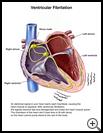
Ventricular Fibrillation
________________________________________________________________________
KEY POINTS
- Ventricular fibrillation is an abnormal heart rhythm that is irregular and very fast. It starts suddenly and needs to be treated right away to prevent brain damage or death.
- Treatment may include CPR, defibrillation to deliver an electric shock to the heart, medicines, and surgery.
- The best way to prevent arrhythmia is to have a heart-healthy lifestyle, and to follow your provider’s instructions for treatment of high blood pressure or heart disease.
________________________________________________________________________
What is ventricular fibrillation?
Ventricular fibrillation (also called V-fib or VF) is an abnormal heart rhythm that is irregular and very fast. If you have VF, the heart muscle pumps little or no blood to your heart muscle or the rest of your body.
VF starts suddenly and needs to be treated right away to prevent brain damage or death.
What is the cause?
V-fib can happen when the heart muscle does not get enough oxygen--for example, during a heart attack. The lack of oxygen affects the electrical signals that start each heartbeat. The signals become fast and disorganized and make the heart muscle quiver. The chambers of the heart don't have time to fill with blood, so the heart cannot pump blood to the rest of the body.
In addition to heart attack, less common causes include:
- Narrowing of the arteries that bring oxygen and nutrients to the heart (coronary artery disease)
- Other heart disease
- Some medicines and drugs, such as cocaine
- Electric shock
What are the symptoms?
V-fib is a life-threatening emergency. It quickly causes a loss of consciousness.
If a heart attack is the cause, symptoms before the loss of consciousness may include:
- Chest pain or pressure, squeezing, or fullness in the center of your chest that lasts more than a few minutes, or goes away and comes back (may feel like indigestion or heartburn)
- Pain or discomfort in one or both arms or shoulders, or in your back, neck, jaw, or stomach
- Trouble breathing
- Breaking out in a cold sweat for no known reason
Along with these symptoms, you may also feel very tired, faint, or be sick to your stomach.
Call 911 for emergency help right away if you have these symptoms.
How is it diagnosed?
Tests may include:
- An ECG (also called an EKG), which measures and records your heartbeat. You may have an ECG while you are resting or while you exercise on a treadmill. You may also be asked to wear a small portable ECG monitor for a few days or sometimes a couple weeks.
- After you recover, tests or scans to find what caused the V-fib
How is it treated?
V-fib needs emergency treatment, which may include:
- Cardiopulmonary resuscitation (CPR). CPR is done by pushing on the chest to keep the blood flowing and by blowing air into the lungs to give oxygen.
You can take a class to learn how to give CPR. CPR classes are open to the public and are held in hospitals, fire departments, and community centers.
- Defibrillation. Trained medical responders can use defibrillators to deliver an electric shock to the heart to restore a normal heart rhythm.
Devices called automatic external defibrillators (AEDs) are available in many public places and on some airplanes. These devices allow someone without medical training to start this life-saving treatment before medical responders arrive. Once the pads are attached to the person being treated, the machine does most of the work. AED training is included in many CPR classes.
Treatment after recovery from V-fib depends on the condition that caused it. Treatment may include medicine to:
- Help the heart beat normally
- Lower blood pressure
- Relax blood vessels
- Lower cholesterol
You may need surgery to:
- Improve blood flow to the heart if you have coronary artery disease (bypass surgery)
- Put an electronic device called an implantable cardioverter-defibrillator (ICD) under your skin to detect abnormal heart rhythms and shock the heart back to a normal rhythm
- Make small scars in the heart that will block abnormal electrical pathways (cardiac ablation)
How can I take care of myself?
Follow your healthcare provider's instructions. Ask your provider:
- How and when you will get your test results
- How long it will take to recover
- If there are activities you should avoid and when you can return to your normal activities
- How to take care of yourself at home
- What symptoms or problems you should watch for and what to do if you have them
Make sure you know when you should come back for a checkup. Keep all appointments for provider visits or tests.
How can I help prevent ventricular fibrillation?
The best prevention is to have a heart-healthy lifestyle. To be heart healthy:
- Keep a healthy weight.
- Eat a healthy diet.
- Stay fit with the right kind of exercise for you.
- Decrease stress.
- Don’t smoke.
- Limit your use of alcohol.
If you have heart disease or high blood pressure, follow your healthcare provider's instructions for treatment.
You can get information about classes for CPR and other life-saving skills from:
- American Heart Association
800-242-8721
http://cpr.heart.org/AHAECC/CPRAndECC/FindACourse/UCM_473162_Find-A-Course.jsp - American Red Cross
800-733-2767
http://www.redcross.org/en/takeaclass

